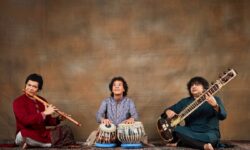JODHPUR:
Ancient India’s ittars, which once reflected a commitment to fine living but lost out to western perfumes due to poor branding and image problems, are poised to make a comeback thanks to the efforts of Indian perfumers reformulating and repackaging them for modern users, according to historian and writer William Dalrymple
In a talk on Scents and Sensuality in India at “Stories of the Desert”, a cultural evening hosted at Jodhpur’s landmark Arna Jharna museum on Saturday, Dalrymple outlined the rich culture of ittars and traditional scents that India once had, and which was over time discarded in favour of French perfumes and western brands.
They are now in the process of being revived through the commitment of people who understand the Indian perfumery traditions’ closeness to nature, he said. He mentioned young perfumier, Jahnvi Dameron Nandan, who is especially working hard to revive it, memorably quoting her: ‘Ittars come from the earth, they are in some way the art of the earth, and are associated with cultures that live close to the earth.’
“Stories of the Desert” was jointly organized by online art and culture resource Sahapedia.org and Rupayan Sansthan, which has been doing pioneering work to document and research the intangible heritage of Rajasthan. Under the larger theme of the event, the focus was on scents and fragrances and Dalrymple’s talk befitted the venue of Arna Jharna: The Thar Desert Museum, which is dedicated to the earthy culture of the Thar.
The evening also featured a folk music concert by some of Rajasthan’s finest Langa and Manganiar musicians on the different kinds of ittars from Rajasthan, ‘antaryo’, and their uses that underscored the fact that this desert state was once also a great centre of traditional Indian perfumery.
“Arna Jharna is an incredibly imaginative, unlikely, innovative museum – the essence of Rajasthani cool and style –displaying objects that people might otherwise take for granted. How delightful it was to be here out in the countryside on a beautiful winter’s evening with the sun setting and the moon rising listening to the brilliant Gazi Khan Manganiar,” said Dalrymple.
The legendary founders of Rupayan Sansthan, Komal Kothari and Vijaydan Detha, both Padma awardees, concentrated on presenting an alternative vision of Rajasthan, highlighting its folk culture and oral history, and documenting folklore.
“What we have set out to achieve in the next phase of Rupayan Sansthan’s development is to organise all the material in the archive built by Kothari and Detha, as well as to make the museum founded by Kothari, Arna Jharna, into a popular place for public engagement,” said Kuldeep Kothari, Secretary, Rupayan Sansthan.
Sahapedia, with its expertise in digital cultural engagement, has been helping the Sansthan with their social media outreach besides advising on long-term plans for the future of the institution and helping with their research plans. The Sahapedia team also designed and developed a website for the museum,www.arnajharna.org which was launched by Sahapedia Executive Director Dr. Sudha Gopalakrishnan and Kuldeep Kothari.
Dr. Gopalakrishnan also formally launched the second phase of Sahapedia’s flagship museum mapping project to add 250 more listings to the www.museumsofindia.org portal and initiate the process of making the digital platform transactional so the public cannot just view information on the museums but also buy entry tickets or souvenirs or publications from the museums and access other services online.
Dr. Yashaswini Chandra, who has been consulting with Rupayan Sansthan on behalf of Sahapedia, said, “Through the event we are focusing on the intangible heritage of the region, such as scents and fragrances that are typically not highlighted. On the one hand, Rupayan Sansathan has focused on documenting the folklore ofRajasthan and has built up a rich archive of recordings and research, on the other, their museum, Arna Jharna, is an unusual attempt to re-imagine the museum and present thenuances of traditional life in the desert. For instance, it has collected hundreds of broomsand musical instruments from the far corners of Rajasthan. Both archive and the museum complement each other.”
Dalrymple, speaking on the Rupayan Sansthan said: “I have long admired the work of Komal Kothari and he was a model for me when I was writing about Rajasthan’s oral traditions in my book Nine Lives. I never got to meet the great man himself, but I am thrilled to be in Jodhpur with Sahapedia celebrating India’s rich living cultural traditions in the institution he created in Jodhpur, the city he loved most, and where my study of this country really began’
Artists who performed at the concert included Langa and Manganiar musicians long associated with Komal Kothari and Rupayan Sansthan – Kachra Khan Manganiar, Safi Khan Manganiar, the two Gazi Khan Manganiar, Lakha Khan Manganiar, Anwar Khan Manganiar, Hakam Khan Manganiar, Multan Khan Manganiar, Ghewar Khan Manganiar, Feroze Khan Manganiar, Jassa Khan Manganiar, Askar Khan Langa, Kadar Khan Langa and Ramzan Khan Langa.
The legacy of Komal Kothari includes the cultural division of Rajasthan into areas that produced jowar (sorghum), bajra (pearl millet) and makka (maize). A food festival was held at the event presenting Rajasthani delicacies based on these three primary ingredients: such as ‘bajrey karaab’, ‘bajra ka churma’, ‘makke ke dhokle’, rabodi ki sabzi’ and ‘besan ki mirchi’.




